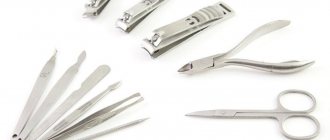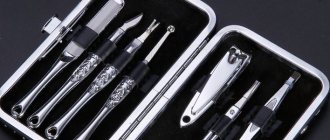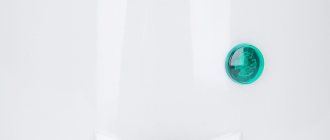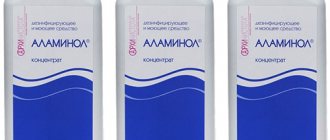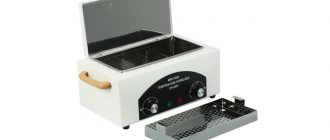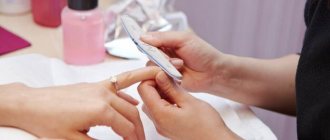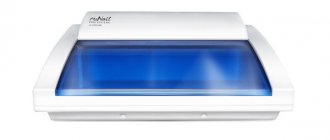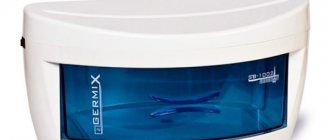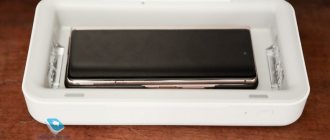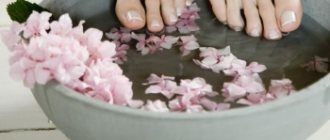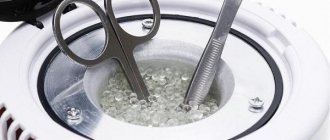Why is sterilization and disinfection necessary? How to properly process instruments? Professionals of the Chistovye brand will tell you in detail all the nuances of processing tools in the new section “DEZlikbez”!
Algorithm for step-by-step disinfection, pre-sterilization cleaning and sterilization of working instruments for nail technicians.
To disinfect professional instruments in nail services, an antiviral regime is in effect, since manipulations during the procedure may be associated with disruption of the skin.
Nippers, pushers, nippers, scissors and cutters are subject to processing.
STAGE ONE – DISINFECTION OF INSTRUMENTS
Instruments should be disinfected in 2% Estilodez working solution. 1 liter is prepared taking into account the following proportions: 20 ml of water per 980 ml of water at room temperature.
When contacting disinfectant solutions, rubber gloves must be used.
Disinfection is carried out by completely immersing the instruments in the working solution for 5 minutes.
Treating hands with antiseptic
Before performing a manicure, you must disinfect your hands and the client’s with a disinfectant. To do this, you can use the following antiseptics: Neosteril, Octenisept, Bacillol, Sterillium, Kutasept F, Eco-breeze. They come either in sprays or in containers with dispensers.
The product is applied to dry hands and distributed evenly over the skin. It is important to carefully work on the inside and back of the hands, the areas between the fingers and around the nails. After this, it is recommended to wear disposable latex or rubber gloves.
Next, the client’s hands are treated with an antiseptic. Use hand sanitizer twice if there is a risk of contracting hepatitis B or tuberculosis.
Recommendations for antiseptic treatment
- The antiseptic is taken from the dispenser into the recess of the palm
- Nails should be clean and cut short
- When working, it is necessary to remove rings, bracelets, watches
- When applying antiseptic, the skin of your hands must be dry.
- It is recommended to use an antiseptic with components to restore the lipid layer so that the skin does not dry out excessively and is less susceptible to injury and cracking.
- The antiseptic is rubbed into the skin of the hands until completely dry.
What instruments are disinfected?
The procedure should be applied to all tools that are used in manicure. Disinfection is performed for:
- scissors;
- wire cutter;
- pusher;
- nail brushes;
- baffy, nail files;
- manicure table, roller, bath;
- LED or UV lamps;
- dots;
- reusable forms.
It is also necessary to disinfect the room, the hands of the master and the client. First you need to determine how disinfection will be carried out - manually or using a device. Typically, the devices are used in salons, and manual processing is carried out at home. But you can also buy equipment for your home, especially if manicures are performed regularly.
Disinfection of manicure instruments - the first stage of treatment
Disinfection is the destruction of bacteria, viruses, fungi and any other microorganisms from working manicure tools and surfaces. It is the first stage of processing. There are three of them: disinfection , pre-sterilization cleaning and the final one – sterilization .
For disinfection in salons and when professionals work at home, a chemical method is used. It is based on the use of special disinfectants in the form of solutions, tablets, and aerosols.
They should have a wide spectrum of effects, which includes antifungal and antiviral effects. The products can be purchased ready-made, or the concentrate can be diluted in the specified ratio.
The ratio is different for each disinfectant, so you must follow the instructions or recommendations of SanPiN. Good disinfection liquids should contain anti-corrosion additives.
Containers with ready-made and prepared solutions must have lids and stickers with the name of the disinfectant, concentration and date of preparation during storage.
Each salon or home technician chooses for himself which disinfectant to use. There is also a list of drugs recommended by SanPiN.
Features and choice of ultrasonic washing in a beauty or manicure salon
conclusions
Now sterilization and disinfection are at a high level, but, unfortunately, not all masters in the nail industry.
Many large salons and beauty studios have their own social networks, where they broadcast their work and everyday life. According to personal observations, 9 out of 10 Chelyabinsk manicure salons tell and show how they process their tools.
Tatyana Sorokina master of manicure and pedicure
The nail industry is developing every day, and consumers of services are becoming more demanding and selective. For most girls, tool processing is the most important factor when choosing a master. Follow all stages of sterilization and disinfection and you will have manicure happiness.
Means for disinfecting manicure instruments when working at home and in beauty salons
After performing a manicure or pedicure, disinfection is the first stage of treatment. Let's look at the most popular options for disinfectant solutions and concentrates. The higher the price of the product, the safer the composition for metal tools is considered.
Before disinfection, all instruments or devices are opened, complex mechanisms are untwisted and immersed in the solution.
It is necessary to ensure that there are no air bubbles or voids left on the surfaces that would prevent the penetration of the product.
Gigasept AF – intended for disinfection of manicure and medical instruments. The prepared solution can be used within 7 days. If it changes color, you need to prepare a new one and discard this one.
Gigasept AF can also be used for pre-sterilization cleaning, the second stage of processing. In this case, after soaking the equipment in the solution, it is enough to rinse it under running water for 10 minutes and additionally immerse it in distilled water for 1 minute. Instruments must be completely dry before sterilization.
Korzolex Plus - can also be used for two stages, disinfection and cleaning before sterilization. The untwisted instruments are lowered into the solution prepared according to the instructions, and the recommended disinfection time is maintained. Then cleaning with a brush is carried out in hard-to-reach places and rinsing with running and distilled water.
After preparation, the solution is recommended for use for no more than 5 days. Both the first and second products can be used in ultrasonic washing baths with metal containers.
Alaminol is a broad-spectrum disinfectant concentrate. The finished solution can be used for no more than 10 days or until the appearance changes. Suitable for use in ultrasonic installations. Dilute strictly according to the instructions, wearing gloves.
Details about choosing a disinfectant:
How to choose a disinfectant, review of the best
Which disinfection solution is better: selection criteria
The huge variety of drugs on the market forces manicurists to carefully study the criteria and requirements for choosing a disinfectant for manicure instruments.
A list of criteria that you need to pay attention to in order to obtain maximum efficiency in your work and to reduce costs:
- Ready solution or concentrate;
- Versatility;
- The need for rotation;
- Ph disinfectant;
- Toxicity class according to GOST;
- Availability of anti-corrosion additives;
- Shelf life of the concentrate;
- Shelf life of the prepared solution;
- Is there a “Disinfection combined with pre-sterilization cleaning (PSC)” mode;
- Availability of documents.
All this is indicated in the instructions for the drug. When working in a salon, it is mandatory to have instructions for the disinfectant on paper. She may be asked when checking a salon or nail salon.
It is often not offered by default when purchasing a product, but is always available upon request. This is due to the fact that the manufacturer packs fewer instructions per large package, since many already have them and are simply updating their stock.
If you need instructions when purchasing a new disinfectant for the first time, be sure to ask for them on paper.
You can also download the instructions from the Internet and print them out.
Let's consider why each of the above criteria for choosing a disinfectant is important, and how it can affect the work process of a manicurist:
- Ready solution or concentrate. Disinfectants are available in two formats - ready-made working solutions and concentrated ones. Ready-made ones do not need to be diluted - they are already ready for use, and the concentrates are combined with water. Ready-made solutions are more convenient, but disinfection in this case is much more expensive.
- Versatility. Make sure that the chosen product is suitable for all types of disinfection - tools, clothing, surfaces, waste. This will allow you to avoid purchasing several types of disinfectants.
- The need for rotation. Look for the phrase “does not require rotation” in the instructions. This means that the composition of the disinfectant is designed in such a way that microorganisms do not develop resistance. Resistance is the resistance of organisms to the effects of disinfectants.
- Ph level. This parameter is specified in the instructions for the disinfectant in the “General Information” section. Why is it so important?
A normal environment acceptable for metal tools should have a Ph from 5.5 to 7.5.Everything below is an acidic environment, everything above is alkaline. The tools are made of metal that “does not like” either acidic or alkaline environments. They cause corrosion in both cases. That is why it is important to pay attention to this indicator. This way you will maintain the performance of the tool much longer.
- Anti-corrosion additives . Their presence also significantly extends the life of a metal manicure tool. The instructions for the disinfectant concentrate should clearly state: does not cause corrosion of metals. This means that anti-corrosion additives are present. If there is no such line, then it is better to use the disinfectant occasionally, not on an ongoing basis. For example, “Alaminol” does not contain anti-corrosion additives and is characterized by an acidic pH environment below 5.5. Experienced craftsmen know what tools become after prolonged use: the metal is destroyed by corrosion and quickly loses its cutting properties and strength.
- Acute toxicity class according to GOST . The instructions, in the “General Information” section, indicate the toxicity class of the disinfectant solution. Avoid products with mild or severe skin and respiratory toxicity (below class 4). Such products cannot be used indoors without protective masks or respirators.
- Shelf life of the concentrate. It can be different, from 1 to 5 years. Pay attention to this parameter taking into account the existing flow of clients. For the salon, you can purchase large volume containers even with a shelf life of 1 or 2 years. If you are a beginner, or work at home with a small number of clients, purchase a concentrate with a longer shelf life or in a smaller container, hoping that it does not expire too quickly before the product is completely used.
- Shelf life of the finished solution . As soon as the concentrate is diluted with water, the shelf life is reduced. It can reach a maximum of 40 days. On average, it ranges from 2 to 21 days for the most common names. Please note that this is the expiration date before the first use of the solution. The instructions for some brands indicate that they can be used repeatedly, until the expiration date, color change or sedimentation occurs. Next, the solution must be replaced. On average, the full effectiveness of the finished solution for disinfecting manicure instruments is 3-4 treatments. Before each dive, visually inspect it to see if the color has changed or there is sediment. The solution can be used if it has not changed.
If you have doubts when visually assessing the appearance of the solution, use special test strips. They are produced for each disinfectant and have their own scale of activity of the working solution. The strip is immersed in the solution for a few seconds, after which it is compared with a color scale.
- Disinfection combined with PSO . The combination of these two characteristics in one preparation makes it possible to save time and money for the specialist. The first stage of pre-sterilization cleaning can be performed directly in the solution after completion of the exposure time specified in the instructions for disinfection.
Availability of documents
For a disinfectant, it is important to have three documents:
- Instructions in Russian;
- Certificate of conformity;
- Registration certificate.
The certificate of conformity speaks about the safety of the product and the possibility of its use on the territory of the Russian Federation, and the registration certificate speaks about the effectiveness of the solution or concentrate.
How to choose a disinfectant, review of the best
Let's take a closer look at the PSO stage.
Step-by-step instructions for disinfecting manicure tools
Please note that disinfection of manicure instruments is carried out immediately after completion of the procedure. They cannot be washed with water, wiped, or brushed off anything with a brush, so that skin residues and other particles or components do not rise into the air or splash with running water on you and in the room.
The disinfection procedure is carried out in 3 successive stages:
- All tools are disassembled and untwisted
- Placed in a pre-prepared bath or disinfection unit with the selected solution
- The time recommended for disinfection with each specific solution is maintained.
The liquid must cover the instruments to 2 cm above them for proper processing. Any manipulations with disinfectant solutions are carried out wearing protective gloves. For practical use and economy, it is better to choose a disinfectant that can also be used for pre-sterilization cleaning. She is the next stage.
Disinfection levels
SanPiN standards officially state three levels of disinfection of medical, manicure and hairdressing instruments:
The instrument must be sterilized after each client
- DPU - intermediate level disinfection, used for instruments that do not have direct contact with the skin and mucous membranes.
- HLD – high-level disinfection, used for instruments that have direct contact with skin or mucous membranes.
- Sterilization – used for instruments that have had contact with blood.
Ideally, the instrument should be sterilized after each client, but if there is no serious damage to the epidermis of the hands, intermediate disinfection with a chemical solution is suitable. If blood appears during a manicure, then sterilization of the instruments is mandatory.
Watch the video for an overview of all the important aspects of disinfecting manicure tools:
Pre-sterilization cleaning of manicure instruments - the second stage of processing
After the period of exposure of the instrument to the disinfectant has expired, it is removed from the solution and cleaned using regular or brass brushes, as well as cotton pads under running water for 10 minutes. Not only dirt and small particles are washed away, but also the disinfectant itself, which damages the instruments with prolonged exposure.
The recommended washing time can vary from 1 to 10 minutes, see the instructions for the drug. After cleaning instruments under running water, it is recommended to place them in distilled water for a minute to neutralize any remaining disinfectant solution.
The first and second stages can be combined in two cases:
- Chemical disinfection and cleaning, where a disinfectant solution simultaneously dissolves dirt and particles. All that remains is to rinse everything and dry it before sterilization.
- Disinfection and cleaning in an ultrasonic cleaner. The combined effect of the solution and vibrations allows you to fully prepare the instruments for sterilization. After exposure, we also rinse everything with running water.
Disinfection and pre-sterilization cleaning of manicure instruments: how to choose a disinfectant and prepare the solution correctly
Criteria for choosing the mode of use of the disinfection solution
To select a disinfection mode, consider the following parameters:
- The purpose of the solution is disinfection or disinfection + PSO;
- The object of processing is metal products for medical purposes;
- Method: manual in a box, or mechanized in an ultrasonic cleaner;
- Virus mode.
Let's look at all this in detail:
- The instructions for the disinfectant concentrate will not indicate “for manicure instruments,” so you need to look for the item “For medical devices, dental or surgical instruments made of metal of simple or complex configuration.” It is better to choose immediately for tools with complex configurations. What does this mean? Such metal instruments have channels, cavities, and locking joints that make it difficult for the solution to penetrate and distribute evenly due to possible air bubbles. Simple configuration - pusher, buffs, manicure scalpel. Complex - tongs, nippers, scissors.
- In the table for the disinfectant solution we also look at the method of processing the instrument. It can be manual or mechanized, in an ultrasonic cleaner.
- In the table we also check that the solution kills viruses. We look at fungi and bacteria secondarily. The antiviral regimen may be indicated in the table, below the table, or in notes.
- The timing of disinfection also plays a big role. Manufacturers make it possible to choose the duration of exposure taking into account the concentration of the solution. The larger it is, the less time is required. Greater concentration makes it possible to save the time of the manicurist, as well as prolong the life of the tool, because it is less exposed to water.
- In the fastest mode, with a high concentration of disinfectant, be sure to strictly observe the time. If you forget about the tool even 10-15 minutes longer than indicated, it will simply deteriorate. Chemical corrosion will appear with a characteristic gray-black tint.
What should the water temperature be to prepare the working solution? Typically, manufacturers indicate from 18°C. This is pleasant to the hands, not icy water. The higher the temperature, the more intense the disinfection process.
Sterilization of manicure instruments - the third stage of processing
The purpose of sterilization is the complete removal of all microflora remaining after the previous stages of processing.
There are several options for sterilization - thermal, chemical, steam, quartz. According to SanPiN, temperature and pressure treatment in a dry-heat oven, autoclave or infrared sterilizer are considered the most effective.
For commercial purposes, only sterilizers that have a registration certificate from Roszdravnadzor are allowed to be used in beauty and manicure salons. This applies to sterilizers of any type.
A sterilizer that has such a certificate is included in the State Register of Medical Devices of the Federal Service for Surveillance in Healthcare. You can check the availability of any sterilizer in this register on the Roszdravnadzor website. Be sure to check sterilization equipment before purchasing.
Here we have described which dry roasts have a registration certificate and which do not.
How to sterilize manicure instruments in a dry heat oven
Dry instruments, after disinfection and thorough cleaning, are placed in special craft bags with color indicators and then sent to the cabinet. If there are no craft bags, you can unfold the tools with tweezers. Sterilization occurs due to exposure to high temperature, from 121 to 180 ° C for 30 minutes.
This sterilization option is also suitable for processing cutters used in hardware manicure.
How to sterilize instruments in an autoclave
The installation is more expensive than a dry-heat oven and is suitable for large salons or clinics. Sterilization occurs due to exposure to steam and high temperature from 121 to 137 ° C under a pressure of 1.5-2 atmospheres. Lasts 20-30 minutes. Distilled water is used.
The full cycle of operation of the autoclave includes: heating-sterilization, cooling of the instrument. The whole process will take about 50-55 minutes.
The advantage of an autoclave is the ability to process any products and manicure tools. Compared to a dry-heat oven, a number of materials that are destroyed by high temperatures cannot be placed in it.
For autoclave processing, paper or plastic bags are used. Plastic ones are transparent, cost a little more, but keep the instrument sterile longer.
According to SES standards, when sterilizing with an autoclave, a sterilization quality log must be kept. To fill it, test strips are purchased, which are placed on bags or inside bags with instruments during each sterilization. After the processing cycle, stickers with color indicators about the quality of the procedure are transferred to the journal.
How to keep logs of quality control of PSO and concentrations of working solutions according to SanPiN
According to the European standard, autoclaves are divided into 3 classes:
- Class N
- Class S
- Class B
Category N devices are not recommended for nail salons, as packaging cannot be used in them. They process all-metal objects without planes and channels, as well as fabric. These models do not have preliminary vacuumization and drying, so the bags turn out wet after sterilization. There can be no question of any further storage of wet Kraft bags.
Autoclaves of categories S and B can be used for work in a salon or nail salon. They provide vacuumization and drying, and you can process tools in bags.
The full cycle of operation of the autoclave includes: heating-sterilization, cooling of the instrument. The whole process will take about 50-55 minutes.
Autoclave - features, choice and operating rules
Infrared sterilizer
There are only two models of infrared sterilizers approved by Roszdravnadzor on the market:
- ST-IK RELMA;
- ST-IK MAI.
The price of each is about 50,000 rubles. Processing in devices occurs under the influence of a temperature of about 200 degrees, but since this is infrared radiation, the metal does not deteriorate.
ST -IK RELMA provides packaging. It is reusable and expensive. Also included is a stand for cutters.
Processing is extremely fast: 10 minutes for packaged and 6 minutes for unwrapped instruments. The packaging remains sterile for 1 day.
For the infrared sterilizer, it is also necessary to maintain a Quality Log. 1st class indicators are glued to the bags. They connect the packaging lid to the main part. One indicator is enough for one.
There are also 5th class indicators for infrared sterilizers. They are inserted directly into the packaging, and after processing they are pasted into the magazine.
Choosing an infrared sterilizer - review of models
for the ST-IK MAI . Instruments are processed open and must then be used immediately or stored in sterile boxes, a sterile cabinet or a UV sterilizer.
Chemical sterilization
A method carried out using special solutions. Must be performed under sterile conditions using sterile containers, rags, and tweezers for contact with instruments. Conditions must be created for further sterile storage. The result is valid for 3 days. It is not always effective in everyday life in nail salons, however, it is the best backup option if all conditions of the procedure are met.
Chemical sterilization of manicure instruments: rules according to SanPiN
Quartz, ball or glasperlene sterilizer
It has both pros and cons. Pros:
- rapid sterilization under high temperature, takes 20 seconds
- mobility – convenient to use by one specialist in the salon, at home and on the road
- possibility of sterilization of cutters for hardware manicure.
Minuses:
- incomplete immersion of the instrument into the treatment area (balls), and as a consequence the risk of re-spread of pathogenic microflora
- The operating temperature of the device does not always correspond to the declared one, which leads to incomplete sterilization
- the need to replace balls every six months, which many craftsmen are not aware of
- rapid wear of cutting parts due to frequent contact with hard balls.
Properties of glasperlene sterilizer and rating of the best
- Ultrasonic sterilizer , despite its name, is intended for the first two stages - disinfection and pre-sterilization cleaning.
- The ultraviolet sterilizer is intended only for storing already sterilized instruments.
Drying
After cleaning and rinsing the instrument under running water, wipe it with disposable towels or napkins and lay it out to dry. You can do this on a regular towel, which is used only for this purpose, or on a large non-woven napkin. The instrument can be dried either open or covered with a napkin.
Instruments that have not been dried should not be sterilized, either thermally or chemically. This is a violation of SanPiN requirements.
If the dryer has a drying function, then after PSO the instruments can be immediately placed in the sterilizer chamber and the pre-drying mode can be turned on. The disadvantage of this method is that the products cannot be packaged in craft bags and the process itself significantly increases the duration of sterilization.
You can also use a special drying box for drying tools - this is offered by the RELMA company. The device helps dry instruments in 15-25 minutes.
Using a drying box does not require any specific skills:
- Open the box lid;
- Place the tools in 1 layer and close the lid;
- Set the timer and wait for the device to finish operating.
The dried manicure tools are packaged in craft bags and sent for sterilization - in a dry heater or autoclave.
Sukhozhar - types, choice, use of a sterilizer
For chemical sterilization, it must be used within an hour.
MU 287-113 Guidelines for disinfection, pre-sterilization cleaning and sterilization of medical devices
Processing of manicure instruments according to SanPiN
To sterilize instruments in a nail salon, you can use several types of sterilizers, which are permitted according to SanPiN 2.1.2.2631-10, SanPiN 2.1.3.2630-10:
- Dry heat cabinet
- Infrared sterilizer
- Autoclave
- Glasperlene sterilizer
To store already sterilized open instruments, you can use a UV sterilizer; they will remain there for up to 3 days; then it is recommended to repeat the procedure. Manicure tools are placed in it open on perforated trays. According to SanPiN standards, manipulations are performed with gloves.
Clause 9.22 of the SanPiN standards for a nail salon or office requires sterilization and storage of consumables and instruments in sterilization packaging materials or craft bags. If sterilization is performed without packaging, then the instruments should be reused within an hour or stored on special perforated trays in closed UV sterilizers for up to 3 days.
An ultrasonic sterilizer is used to clean and disinfect instruments after a manicure or pedicure. After ultrasonic cleaning, the instruments must dry and undergo heat treatment in an autoclave or dry-heat oven.
The sterilization procedure according to SanPiN takes place in three stages prescribed by the SES:
- After performing a manicure or pedicure, all instruments are soaked in a disinfectant solution in accordance with the exposure time and concentration recommended by SanPin.
- After disinfection, instruments undergo pre-sterilization mechanical cleaning under running water using brushes or brushes, depending on the hardness of the surface being treated. Processing time under running water is from 2 to 10 minutes. This is necessary in order to remove not only the remaining protein particles on the surface, but also to thoroughly rinse off the disinfectant solution, which can cause corrosion during further sterilization at high temperatures.
Pre-sterilization cleaning can be carried out together with disinfection using a mechanized method using a device, for example, an ultrasonic cleaner.A removable tray with a disinfectant solution is placed inside the device, the instruments are immersed, and the recommended treatment time is set for each specific model. On average it is 2-10 minutes.
- Sterilization in a dry-heat oven or autoclave is performed for dry instruments that have undergone disinfection and pre-sterilization cleaning. They are laid out on special trays and placed in a cabinet or autoclave for the recommended time. It is set depending on the selected temperature and can vary from 20 to 90 minutes.
More detailed information on sterilization standards for nail salons and offices can be found in the documents that can be downloaded:
New sanitary and epidemiological rules SP 2.1.3678-20 from January 1, 2022:
- SP 2.1.3.2630-10
What has changed in SanPiN since 2022 >>
Learn more about the requirements of SanPiN and SES standards for the manicure salon in general, as well as for nail technicians.
Clause 9.21 also prescribes the need for at least three standard manicure sets per master’s workplace. This is necessary in order to ensure uninterrupted disinfection and sterilization with a dense flow of clients. The standard set is approved for each salon individually by the administration of the institution. The administration must also appoint an employee responsible for disinfection and sterilization who has undergone preliminary training. This is stated in paragraph 9.26 of SanPiN 2.1.2.2631-10.
Main stages
Sterilization of instruments after a manicure is carried out in stages:
- Pre-sterilization treatment. First you need to remove the remaining biomaterial from the instruments, then wash the instruments in running water with soap, removing visible dirt. After this, manicure accessories should be placed in a plastic container and subjected to chemical treatment.
- Sterilization. The process is performed using special equipment. Instruments are sterilized strictly when dry.
- Storage. The final stage is additional disinfection and storage. To do this, you will need an ultraviolet light sterilizer equipped with a box for processed devices. You can place tongs, brushes, files, buffs in it. When sterilizing using bags, it is important to maintain their seal. Before performing a cosmetic procedure, the package is opened in full view of the client, and the instruments are additionally wiped with alcohol or an antiseptic.
Dry-heat cabinet: processing and sterilization of instruments according to SanPiN
Sukhozhar, along with a glasperlene sterilizer, are the most popular devices for sterilizing manicure instruments in salons and by craftsmen at home.
A dry-heat cabinet is an electrical device that exposes a manicure tool to high temperatures - from 160 to 220°C. Depending on the set temperature, the exposure time to dry air also changes. At 180-220°C – 30 minutes, at 170-180°C – 90 minutes, and at 160-170°C – 150 minutes.
These data may vary slightly from model to model, so you should read the instructions before using the device. There are also temporary SanPiN standards for different types of material and tools.
It is important to consider the time it takes to warm up the cabinet itself to the desired temperature. It can last from 5 to 10 minutes, and then the sterilization time begins to count down. On many models this is indicated by a colored indicator light.
The processing algorithm in a dry-heat oven is as follows:
- The instruments are placed in a tray or tray and sent to the chamber. When using Kraft bags, they are first packaged in bags and then placed on a tray or tray;
- Close the lid and set the processing time and temperature;
- After completing the procedure and turning it off, it is necessary to allow time to cool down, and then remove the sterilized material and place it in storage or reuse it.
Only parts made of heat-resistant metal that can withstand temperatures from 180 to 220°C are sterilized in a dryer and autoclave.
According to SanPiN standards, a dry-heat oven, like other types of sterilizers, must be certified for use in Russia, have a passport, instructions in Russian and a maintenance guarantee. Only models approved by the Ministry of Health are allowed for use in the salon.
It is mandatory to have a purchase and sale agreement for equipment and an invoice.
The average device has dimensions of no more than 45 cm. According to SES standards, it must be installed on a flat surface with a distance of 8 cm from the front edge, 10 cm from the back wall with the electrical wire and on the sides, and 30 cm from the top. It is not necessary to allocate space for a dry heat special table.
Sukhozhar - types, choice, use of a sterilizer
Rating of dry heat sterilizers
Recommendations
To make the procedure safe, you must follow simple rules:
- You should wait until the instruments cool down to prevent burns.
- You cannot cool the devices in cold water; they must cool down on their own, otherwise they may deteriorate.
- You should purchase antiseptics and sterilizers not based on price, but on quality and functionality. The action of cheap drugs is not aimed at eliminating all causative agents of various ailments.
Even if a manicure set is used at home, it must also be disinfected. The procedure eliminates bacteria and makes the devices suitable for further use.
The article presents all the ways to disinfect manicure tools at home. With their help, manicure will be a high-quality and safe procedure.
How to sterilize manicure supplies at home
If the tools are used infrequently, it may be enough to simply wipe down all the tools with an alcohol solution . gas oven for help : preheat it to 220 º C and place the washed instrument in it. The duration of this procedure is from 15 minutes. There should be a small distance between the elements during the procedure. Immediately after sterilization, the devices do not need to be taken out and cooled, just wait until they cool down on their own.
Solution for disinfection of manicure instruments
The second method of home sterilization is boiling . To do this, put the items in a pan and add water so that it completely covers them. After 15-20 minutes of boiling, drain the water and let the instruments cool, placing them in a case or sealed bag to maintain a sterile state.
The third method is disinfection of devices using a self-prepared solution . It will require 100 ml of alcohol, 10 grams of sodium tetraborate with glycerin and 30 grams of potassium permanganate (potassium permanganate). Pour all the ingredients into the flask and shake a little until the solution becomes cloudy. If this does not happen, add another 30 grams of manganese, 5-10 grams of tetraborate and mix again. When mixed correctly, the solution will turn light pink with a purple tint. This liquid is considered a professional disinfectant and is widely used in salons.
After processing, all instruments can be placed in a special craft bag, which guarantees complete preservation of the sterile condition of the instruments for up to 3 days. Also used for up to 20 days are sealed bags and a paper bag with heat sealing (up to 30 days).
How to recycle disposable materials
Before disposing of disposable brushes and files, it is also necessary to disinfect them in a solution, only after that you can dispose of them in a closed trash container!
For swabs and cotton swabs with blood, there should also be a separate container with a solution for soaking.
You can learn more about instrument sterilization and other manicure features in our Nail-master manicure school. You can get acquainted with the full range of professional products TM “Cosmake” in our catalog.
Author of the article Olga Kukina, official technologist of TM “Cosmake”
